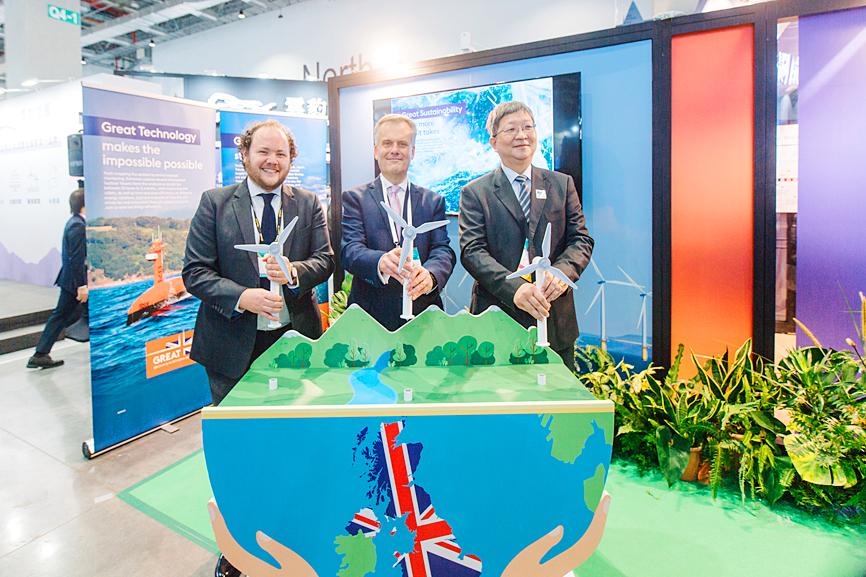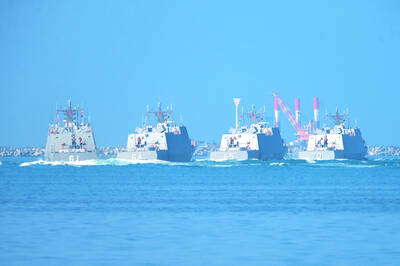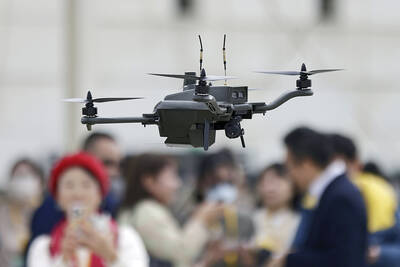Taiwan’s solar and wind energy installations would generate revenue of more than NT$2 trillion (US$72.09 billion) and create 160,000 jobs by 2025, President Tsai Ing-wen (蔡英文) said yesterday, reiterating the nation’s resolve to energy transition.
Tsai made the remarks at the opening of the three-day Energy Taiwan exposition at the Nangang Exhibition Center’s Hall 2 in Taipei.
Exports of Taiwan’s semiconductor manufacturing facilities in the third quarter exceeded US$7.3 billion, making it the biggest market in the world, Tsai said, citing Semiconductor Equipment and Materials International data.

Photo courtesy of the British Office Taipei
The booming semiconductor industry is increasing demand for green power, while the government is committed to expanding the green energy industry, she said.
By 2025, the nation’s wind and solar power installations would create investments of up to NT$1.7 trillion, revenue of more than NT$2 trillion and 160,000 jobs, Tsai said.
“The UK is supporting Taiwan in its energy transition,” British Representative to Taiwan John Dennis said at the British pavilion later. “We are partnering with Taiwan to turbocharge its offshore wind sector and become the regional leader in clean growth.”
“Now, Taiwan is the UK’s largest offshore wind market in Asia-Pacific,” Dennis said. “I would like to congratulate the Bureau of Energy and the Ministry of Economic Affairs on their third round offshore wind development plan, and their target to achieve 20.5 gigawatts in capacity by 2035.”
Taiwan, although it was not part of the COP26 negotiations, has an important role to play, as it is the world’s 21st-largest economy and a top-25 emitter of carbon dioxide, he said.
The envoy also welcomed Taiwan’s commitment to carbon neutrality by 2050 and its plan to legislate a carbon pricing scheme.
“The UK’s credit agency ... has provided more than £500 million [US$659.78 million] in credit guarantees to three offshore wind farms in Taiwan,” he said.
It is the first time that the British Office Taipei has had a UK-themed pavilion at the annual energy exposition, the office said.
There are more than 30 British offshore wind companies with offices in Taiwan, with eight — Aggreko International Projects, Correll Electrical Engineering Taiwan Branch, CWind Taiwan, Flotation Energy Taiwan, James Fisher Renewables, Offshore Wind Consultants Taiwan, Taiwan Mott MacDonald and Taylor Hopkinson — exhibiting, it said.
The companies are to demonstrate the breadth of British expertise, including offshore wind farm planning and construction, engineering consultancy, crew transfer vessels, operations and maintenance, blade services, floating wind technology, and temporary power and temperature solutions for offshore wind farms, it said.
Also at the exposition are a handful of German and Dutch companies, including RWE Renewables Taiwan, Phoenix Contact and Boskalis Hwachi Offshore Wind Taiwan.
The COVID-19 pandemic has hindered the progress of some offshore installations, but the situation is expected to improve from next year, German Offshore-Wind Initiative Taiwan representative David Chiang (蔣大巍) said.
Many energy developers are competing for the third phase of Taiwan’s offshore wind farm plan, after the ministry in July started accepting applications, he said.
Floating wind technology is expected to become a new trend, Chiang said, adding that the government should ensure the consistency of energy policy to minimize the risks for energy developers.

FOUR DESIGNATED AREAS: Notices were issued for live-fire exercises in waters south and northwest of Penghu, northeast of Keelung and west of Kaohsiung, they said The military is planning three major annual exercises across the army, navy and air force this month, with the navy’s “Hai Chiang” (海強, “Sea Strong”) drills running from today through Friday, the Ministry of National Defense said yesterday. The Hai Chiang exercise, which is to take place in waters surrounding Taiwan, would feature P-3C Orion maritime patrol aircraft and S-70C anti-submarine helicopters, the ministry said, adding that the drills aim to bolster the nation’s offshore defensive capabilities. China has intensified military and psychological pressure against Taiwan, repeatedly sending warplanes and vessels into areas near the nation’s air defense identification zone and across

FORCED LABOR: A US court listed three Taiwanese and nine firms based in Taiwan in its indictment, with eight of the companies registered at the same address Nine companies registered in Taiwan, as well as three Taiwanese, on Tuesday were named by the US Department of the Treasury’s Office of Foreign Assets Control (OFAC) as Specially Designated Nationals (SDNs) as a result of a US federal court indictment. The indictment unsealed at the federal court in Brooklyn, New York, said that Chen Zhi (陳志), a dual Cambodian-British national, is being indicted for fraud conspiracy, money laundering and overseeing Prince Holding Group’s forced-labor scam camps in Cambodia. At its peak, the company allegedly made US$30 million per day, court documents showed. The US government has seized Chen’s noncustodial wallet, which contains

SUPPLY CHAIN: Taiwan’s advantages in the drone industry include rapid production capacity that is independent of Chinese-made parts, the economic ministry said The Executive Yuan yesterday approved plans to invest NT$44.2 billion (US$1.44 billion) into domestic production of uncrewed aerial vehicles over the next six years, bringing Taiwan’s output value to more than NT$40 billion by 2030 and making the nation Asia’s democratic hub for the drone supply chain. The proposed budget has NT$33.8 billion in new allocations and NT$10.43 billion in existing funds, the Ministry of Economic Affairs said. Under the new development program, the public sector would purchase nearly 100,000 drones, of which 50,898 would be for civil and government use, while 48,750 would be for national defense, it said. The Ministry of

SENATE RECOMMENDATION: The National Defense Authorization Act encourages the US secretary of defense to invite Taiwan’s navy to participate in the exercises in Hawaii The US Senate on Thursday last week passed the National Defense Authorization Act (NDAA) for Fiscal Year 2026, which strongly encourages the US secretary of defense to invite Taiwan’s naval forces to participate in the Rim of the Pacific (RIMPAC) exercise, as well as allocating military aid of US$1 billion for Taiwan. The bill, which authorizes appropriations for the military activities of the US Department of Defense, military construction and other purposes, passed with 77 votes in support and 20 against. While the NDAA authorizes about US$925 billion of defense spending, the Central News Agency yesterday reported that an aide of US